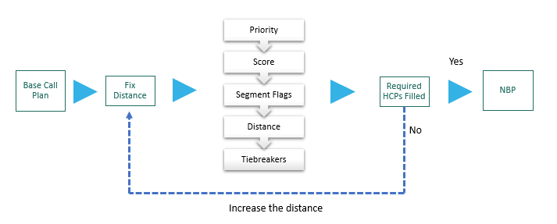Traditional pharmaceutical marketing channels no longer generate the response rate they once did in today’s healthcare environment. Pharmaceutical products need a significant promotional push to grab market opportunities and meet sales expectations. Historically, face-to-face (F2F) interaction between sales reps and the healthcare professionals (HCPs) who practice within defined geographic regions has been the most common channel for detailing pharma products. Sales reps can only make a limited number of daily calls, so if calls are not planned carefully, using the most efficient route possible, valuable time is wasted. Careful consideration of two parts of this traditional approach to pharma sales can yield significant improvements in meeting sales goals:
- Target scheduling: Pre-prioritizing HCP visits to identify high-value HCPs instead of lower-value HCPs is challenging. Even with good geographical knowledge, available detailing hours can conflict with other targets if not planned, which leads to poor productivity. Reps with less demographic experience deal with more challenging situations.
- Identifying the Least Cost Path (LCP): Route options available to reps are not always flexible and can vary by locality. The ability of a sales rep to deliver an optimal number of calls is crucial to sales goals. It can be hindered by unfamiliar routes and the feasibility of specific modes of transportation. An efficient sales route is necessary for cost-efficient commutes, better sales, and the well-being of sales reps.
Least Cost Path (LCP) uses the cost-weighted distance and direction surfaces for an area to determine a cost-effective route between a source and a destination.1
With the easing of COVID-19 restrictions, revising promotional strategies for a more significant impact and better utilization of sales reps’ work hours is essential. Rep visits based on their local knowledge may not be enough to achieve a higher than expected output in the future. They will need to adapt to changing customer preferences.
The following case study illustrates Axtria’s cutting-edge cloud-based product, Axtria SalesIQ™, which provides methodical and visually interactive tools that prioritize sales calls to high-value HCPs.
Business scenario
A leading pharma company needed help identifying their most valuable HCPs, so their sales reps could plan their daily calls more efficiently. This problem needed to be assessed from the following angles:
- HCP value: Several lower-value HCPs might not write as many prescriptions as one high-value HCP.
- HCP proximity and accessibility: It is critical to consider where HCPs are located geographically and how much effort is required to reach each one.
The distance between HCP locations is imperative and can impact successive calls. Sales reps’ speculation when determining the next HCP location in the closest proximity of the next-best high potential HCP opens doors for more impactful calls. The distance and HCP value must be used together to achieve optimum visits during the day. Another purpose of putting distance into the equation is to reduce the commute and time spent on less productive sales activities.
With critical segmentation and call planning components in place, the next thing needed to complete the puzzle is “visualization of the data.” Better visuals and representation provide the sales reps with a more accessible and engaging user interface (UI).
The pharma company needed the following components to achieve their desired solution:
- Integration of latest data: Data needed to be pulled from the CRM system (their primary source of customer information). The goal was to fetch the latest available demographic data like the HCP’s address, latitude, longitude, and GPS location.
- Reliable analytics engine: The analytics engine needed to be designed to deliver the best result for all possible detailing scenarios in seconds. It needed to be robust enough to digest various business rules and provide accurate map locations.
- Better visualization: Modern reporting capabilities bring better ways to represent the results instead of the old tabular structures (i.e., data tables). A solution that provided better visualization for the content’s ease of understanding and readability.
- Efficient UI: The pharma company requested a user-friendly application with easy navigation, accessibility, and content consumption to increase the tool’s effectiveness for their end-users (i.e., the sales reps).
- Zero downtime: The application needed to be online 24x7 without disrupting the services, with minimal downtime.
Axtria’s approach
Axtria provided an end-to-end sales planning and operations product suite to address the pharma company’s pain areas. Some of the highlights of the application were:
- Targeting process syncing: The next-best physicians (NBP) were selected from existing call plans to focus on the most valuable HCPs.
- Multiple metrics based on NBP definitions:
- Priority - determines the value of each HCP.
- Distance - determines the proximity of the NBP.
- The composite value score - assesses the significance or value of an HCP using brand-specific rules.
- Finding the quickest and most efficient sales call route: Iterations were used to increase reach with each iteration in instances where NBPs were not present in a specific range. With each iteration, the distance to search for the NBPs is increased to fill the required number of NBPs.
- Multiple geographic views with an option to switch to Google Maps for navigation: Axtria’s solution plotted NBPs on maps with drilled-down views of the selected geographies and allowed the user to switch from the native UI to Google Maps for navigation. Using the latitude and longitude of NBP locations helps create the complete navigation path from the reps’ current location.
- UI requirement-based data formatting: Data visualization was enhanced through business intelligence tools for an intelligent UI, and data was formatted per the requirements for better visualization.

Figure 1: An overview of the NBP suggested via Axtria’s solution
Takeaways and benefits
- High call plan adherence: The sales reps can now call on more high-value HCPs by following the NBP suggested call route. The optimized commute plan significantly reduces commute time and makes time for more calls, leading to an optimized detailing process, increased call plan adherence, and enhanced efficiency.
- Reduced commute costs: Reps can now save time and money with optimized call and route suggestions and an optimally managed travel budget.
- Focused targeting: Prioritization of visits saves time between targets, allowing efficient operations. Reps now have better clarity on daily activities and a clear HCP targeting plan.
- Efficient UI: Efficient UI gives users easy access to drilled-down views and identifies the next-best locations. The navigation option helps reps visually analyze call plan locations for a clearer picture of their daily routes.
- Flexibility in metrics: The metrics defining NBPs can be changed easily to correlate with the targeting process. This allows sales teams to customize the prioritization of sales visits based on HCP-level data, such as priority and distance.
- Regular updates: The complete process can be updated with the latest available information at planned intervals. In addition, the NBP algorithm can be updated with feedback from sales reps so that it stays coordinated with calling plans.
Conclusion
By providing our client with an out-of-the-box solution, Axtria SalesIQ™, we helped them determine efficient sales routes that saved reps valuable time so they could meet with more high-value HCPs daily. Sales reps no longer had to guess the quickest and least costly route for their sales calls. The most efficient route to high-value HCPs was made available in a user-friendly interface that allowed reps to update information easily, making future routes and information more accurate. By using this approach to target scheduling and least-cost path analysis, our client experienced greater call plan adherence and reduced commute costs.
References
- The City University of New York. Least-cost path analysis. Available from http://www.geography.hunter.cuny.edu/~jochen/GTECH361/lectures/lecture11/concepts/Least-cost%20path%20analysis.htm [published online April 4, 2022]





